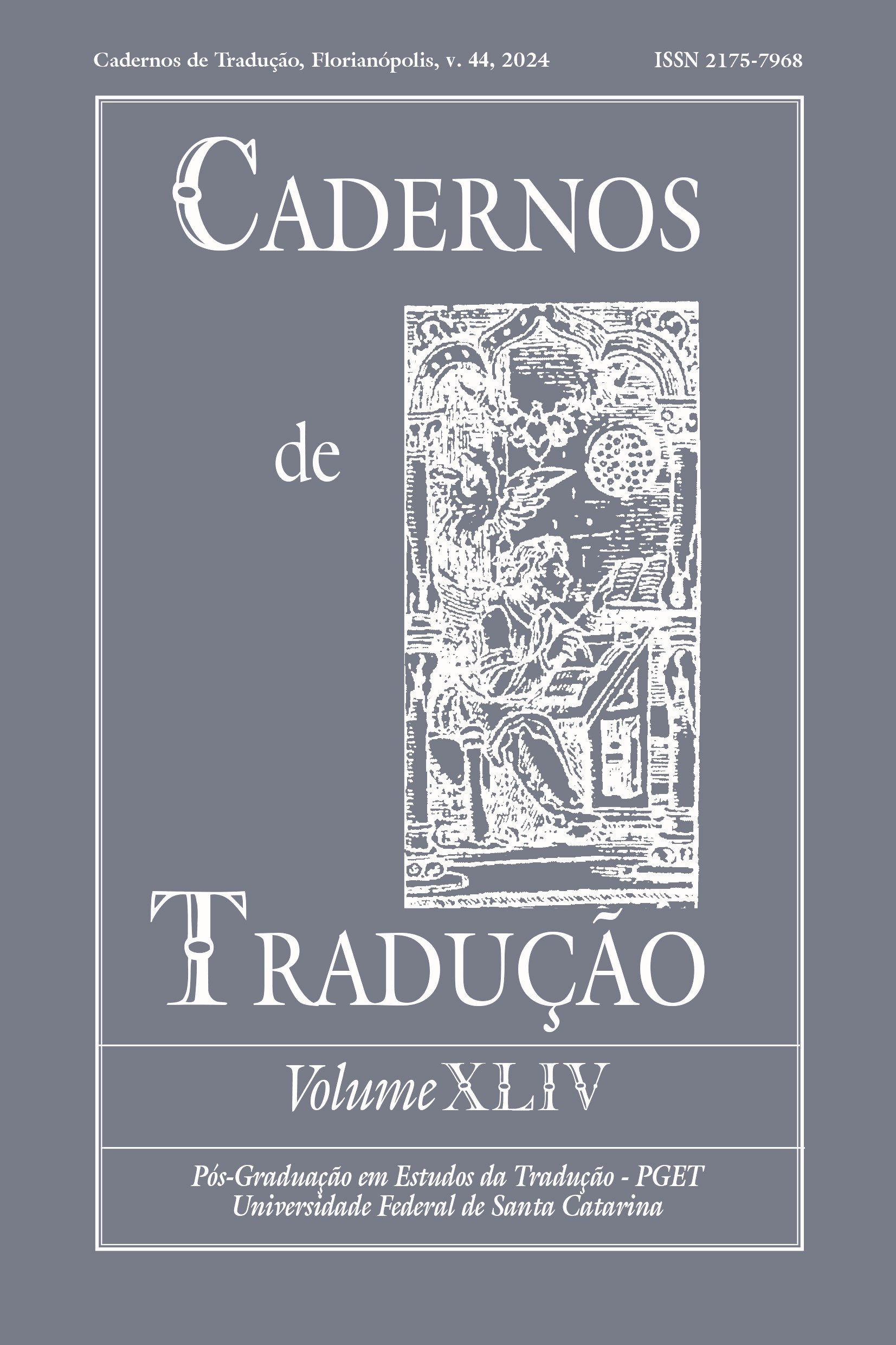Translation and use of the N... word in French: From Ten little niggers to They were ten
DOI:
https://doi.org/10.5007/2175-7968.2024.e94511Keywords:
Nigger/Nègre, lexical sociolinguistics, intralingual translation, retranslation, deconstruction of imaginariesAbstract
When the French retranslation of the novel Ten Little Niggers, by Agatha Christie, renamed They were ten, was published in 2020, the Christie Corporation declared that this new version of the work makes sense. According to the press release, in the century of the author the language was different. To question the validity of this argument, our study focuses on the translation and use of the term Nigger/Nègre (noun/adjective) in metropolitan French. The corpus is composed of the original work Ten Little Niggers (1939), its interlingual translation (1940) and retranslation (2020). These concepts are examined in the first part of the study in support of the theoretical bases of intertextuality. The second part follows the journey of the lexie in the United States, notably through the popularization of the original eponymous nursery rhyme. The third part aims to demonstrate that, like the sociolinguistic status of the N… word in the United States, the lexie Nègre/nègre has never integrated the usual vocabulary of French. These are all elements that make it possible to contest or even invalidate the argument presented by the author's heirs. The conclusion exposes the results of the CRAN/IPSOS discrimination barometer in France (2023) and underlines the need to deconstruct the institutionalized colonial imaginary.
References
Alain, J.-R. (2020, 26 août). Dix petits nègres d’Agatha Christie change de titre. La Tribune. https://www.latribune.ca/2020/08/26/dix-petits-negres-dagatha-christie-change-de-titre-9f60b121c9d104bcc1550c21eef154e1
Amazon. (2020). 10 petits nègres d’Agatha Christie interdit sur amazon. Amazon France. https://sellercentral.amazon.fr/forums/t/10-petits-negres-dagatha-christie-interdit-sur-amazon/29705
Anderson, T. M. B. (2009). “Ten Little Niggers”: The Making of a Black Man’s Consciousness. Folklore Forum.
Ballard, M. (2019). Traducteurs et "traductologues" latins : de Cicéron à Boèce. In M. Ballard (Ed.), Antiquité et traduction : De l'Égypte ancienne à Jérôme. (pp. 59−76). Presses universitaires du Septentrion. https://doi.org/10.4000/books.septentrion.36919
Bensimon, P. (1990). Présentation. Palimpsestes, 4, 9−13. https://doi.org/10.4000/palimpsestes.598
Berman, A. (1990). La retraduction comme espace de la traduction. Palimpsestes, 4, 1−7. https://doi.org/10.4000/palimpsestes.596
Berman, A. (1991). La traduction et la lettre ou L'auberge du lointain. Seuil.
Berman, A. (1995). L’Épreuve de l’étranger : culture et traduction dans l’Allemagne romantique : Herder, Goethe, Schlegel, Novalis, Humboldt, Schleiermacher, Hölderlin. Gallimard. (Œuvre originale publiée 1984).
Christie, A. (1939). Ten Little Niggers. Collins Crime Club.
Christie, A. (1940). And Then There Were None. Dodd, Mead & Co.
Christie, A. (1964). Ten Little Indians. Pocket Book.
Christie, A. (2002). Dix petits nègres. (L. Postif, Trad.). Librairie des Champs-Élysées.
Christie, A. (2020). Ils étaient dix. (G. de Clergé, Trad.). Le Masque.
Collombat, I. (2004). Le XXIe siècle : l’âge de la retraduction. Translatio Studies in the New Millennium, 2, 1−15.
CNCDH. Commission Nationale Consultative des Droits de l’Homme. https://www.cncdh.fr/
CRAN. (2023, 28 février). Les résultats du 2ème baromètre des discriminations CRAN / IPSOS repris dans les médias. Le Conseil Représentatif des Associations Noires. https://www.lecran.org/societe/les-resultats-du-2eme-barometre-des-discriminations-cran-ipsos-repris-dans-les-medias/
Dictionnaire de l’Académie française. https://www.dictionnaire-academie.fr/
Gambier, Y. (1994). La retraduction, retour et détour. Meta, 39(3), 413–417. https://doi.org/10.7202/002799ar
Gambier, Y. (2011) La retraduction : Ambigüités et défis. In E. P. Monti, P. Schnyder (Eds.), Autour de la retraduction: Perspectives littéraires européennes. (pp. 49−66). Orizons.
Garrigues, J. Pourquoi le roman "Dix petits nègres" d’Agatha Christie a été renommé "Ils étaient dix". Europe 1. https://www.europe1.fr/culture/le-roman-dix-petits-negres-dagatha-christie-renomme-ils-etaient-dix-3987807
Genette, G. (1982). Palimpsestes. Seuil.
Guinness World Records. https://www.guinnessworldrecords.com/
Hofmann, S. (2005). Rethinking Agatha Christie: The Strange and Offensive History of Ten Little Indians. Rethinking Schools, 20(1).
Jacobs, A. (2018, 13 September). Ten Little Indians: A Genocidal Nursery Rhyme. Indian Country Today. https://indiancountrytoday.com/archive/the-history-of-ten-little-indians
Jakobson, R. (1963). Essais de linguistique Générale. (N. Ruwet, Trad.). Editions de Minuit.
Jakobson, R. (2013). On Linguistic Aspects of Translation. In R. A. Brower (Ed.), On Translation. (pp. 232−239). Harvard University Press. https://doi.org/10.4159/harvard.9780674731615.c18
Jennings, J. (2018, 13 September). “Ten Little Indians”: How did the genocidal nursery rhyme come about? Indian Country Today. https://indiancountrytoday.com/archive/the-history-of-ten-little-indians
Kennedy, R. (2022). Nigger: The Strange Career of a Troublesome Word. Pantheon Books. (Œuvre originale publiée 2002).
Koskinen, K., & Paloposki, O. (2003). Retranslations in the Age of Digital Reproduction. Cadernos de Tradução, 1(11), 19–38.
Kristeva, J. (1969). Semiotikè: Recherches pour une sémanalyse. Éditions du Seuil.
Leff, L. J. (1984). David Selznick's Gone With the Wind: the Negro Problem. The Georgia Review, 38(1), 146−164.
Les Observateurs. "Mamadou", "tête de nègre", "Bamboula" : ces gâteaux français accusés de véhiculer le racisme anti-noirs. Observers France 24. https://observers.france24.com/fr/20190304-mamadou-tete-negre-bamboula-ces-gateaux-francais-accuses-vehiculer-racisme-anti-noi
Levi-Strauss, C. (1954). Race et Histoire. UNESCO.
Limat-Letellier, N. (1998). Historique du concept d’intertextualité. In M. Miguet-Ollagnier (Ed.), L’intertextualité. (pp. 17−64). Presses Universitaires de Franche-Comté. https://doi.org/10.4000/books.pufc.4507
Meschonnic, H. (1999). Poétique du traduire. Verdier.
Mounin, G. (1963). Les problèmes théoriques de la traduction. Gallimard.
Noël, É. (2007). L'esclavage dans la France moderne. Dix-huitième siècle, 39(1), 361−383. https://doi.org/10.3917/dhs.039.0361
Oliveira, R. de. (2019). French: from Academy to Zouzer. Aracne.
Oliveira, R. de. (2022). Sur l'in/visibilité du traducteur dans les notes explicatives de l'édition française de Capitães da areia / Capitaines des sables de Jorge Amado. (Con)textos Linguísticos, 16(35), 132−149. https://doi.org/10.47456/cl.v16i35.39116
Prairat, E. (2009). Chapitre 1 : Éthique, morale et déontologie. In E. Prairat (Ed.), De la déontologie enseignante. (pp. 7-21). PUF.
Prichard, J. (2020, 26 août). "Dix petits nègres" : le best-seller d'Agatha Christie débaptisé. [Entretien avec Laurent Marsick.] RTL. https://www.rtl.fr/culture/arts-spectacles/dix-petits-negres-le-best-seller-d-agatha-christie-debaptise-7800747182
Renard, C. (2018, 10 mai). De l’esclavage à la négritude : une histoire du mot "Noir". Radio France Culture. https://www.radiofrance.fr/franceculture/de-l-esclave-a-la-negritude-une-histoire-du-mot-noir-9348400
Riffaterre, M. (1981). L’intertexte inconnu. Littérature, 1(41), 4–7.
R.L. (2023, 15 février). Sondage : 9 personnes noires sur 10 se disent victimes de racisme en France. France-Antilles Guadeloupe. https://www.guadeloupe.franceantilles.fr/actualite/societe/sondage-9-personnes-noires-sur-10-se-disent-victimes-de-racisme-en-france-924134.php
Schleiermacher, F. D. E. (2010). Sobre os diferentes métodos de tradução. (C. Braida, Trad.). In W. Heidermann (Ed.), Clássicos da teoria da tradução: alemão-português. (pp. 38−101). Núcleo de Pesquisas em Literatura e Tradução.
Siegel, A. (2015, 4 mars). Grasse : des gâteaux jugés "racistes" vendus en boulangerie. BFMTV. https://www.bfmtv.com/societe/grasse-des-gateaux-juges-racistes-vendus-en-boulangerie_AN-201503040082.html
Sopo, D. (2020, 29 septembre). Le nègre et le néant. Libération. https://www.liberation.fr/debats/2020/08/29/le-negre-et-le-neant_1798036/
Taguieff, P.-A. (2013). Dictionnaire historique et critique du racisme. PUF.
UCLouvain. (2018). Boîte à outils pédagogiques pour l’enseignement de l’éthique. Enseigner l’éthique. https://www.enseignerlethique.be/content/accueil
Venuti, L. (1986). The Translator's Invisibility. Criticism, 28(2), 179−212.
Venuti, L. (2004). Retranslations: The Creation of Value. In K. M. Faull (Ed.), Translation and Culture: Special issue of Bucknell Review, 47(1), 25−38.
Wardle, M. (2019). Eeny, Meeny, Miny, Moe: The Reception of Retranslations and How Readers Choose. Cadernos de Tradução, 39(1), 216−259. https://doi.org/10.5007/2175-7968.2019v39n1p216
Warren, C. A. (2010). Gender and Moral Immaturity in Agatha Christie's “And Then There Were None”. CEA Critic, 73(1), 51−63.
Downloads
Published
How to Cite
Issue
Section
License
Copyright (c) 2024 Cadernos de Tradução

This work is licensed under a Creative Commons Attribution 4.0 International License.
Copyright Notice
Authors hold the copyright and grant the journal the right for their articles' first publication, being their works simultaneously licensed under the Creative Commons Attribution License (CC BY), which allows the sharing of such works with its authorship acknowledged and its initial publication in this journal.
Authors are allowed to enter into separate additional contractual arrangements for the non-exclusive distribution of the journal's published version of the work (e.g., post it to an institutional repository or as a book chapter, with an acknowledgment of its initial publication in this journal).








































